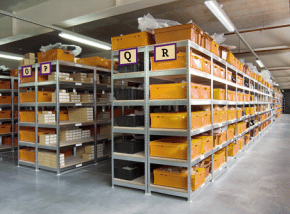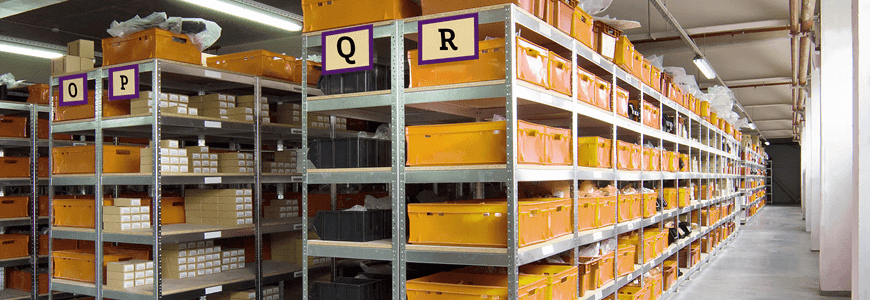Posted by Glenn Pierce on Fri, 09/28/2018
I recently came across this “oldie, but goodie” in Efficient Plant Magazine about the importance of efficiency in MRO Storerooms. The article, written by Wally Wilson of “Life Cycle Engineering,” focuses on why storerooms need extra attention and how updating the location as well as the storage equipment can help in the process of more effectively managing inventoried items. It also focuses on updating layouts, work processes, stocking decisions, kitting approaches, and KPIs in order to get the most efficient use out of your MRO storerooms.
In this highly competitive market where the demand for asset reliability is ever-increasing; where it’s becoming harder to find skilled labor, and where the intellectual property of plants still lies in the minds of the aging (and retiring!) workforce, the need for efficient MRO Storerooms is even more prevalent today. And while utilizing storage methods and moving towards best-in-class processes should certainly be a focus, these methods should be considered in conjunction with a goal of lowering overall inventory by strategically moving from reactive maintenance to proactive and predictive maintenance. Although that transition is never easy, ensuring its success can be addressed in a systematic approach.
Making the Turn
In my past maintenance management experience, we referred to the transition from reactive maintenance to proactive and predictive maintenance as “making the turn.” Making the turn is not just a function of maintenance, it’s a manufacturing function which often involves a significant cultural shift.
Even though it can seem insurmountable, making the turn can begin with small wins to show results and gain traction. One approach is to focus on a small set of machines that have experienced issues in the past as a result of reactive maintenance. By implementing proactive and predictive practices and displaying the results for everyone to see, the team can understand the value of proactive and predictive maintenance while developing the culture for change. The following methods can further assist in these efforts:
- Work with operations to make equipment available for routine inspections. Use the “clean-to-inspect” methodology and include operators when possible.
- Use of visual inspection techniques such as sight glasses for oil levels, bolt registration marks and auto lubrication systems. These tools enable anyone and everyone who walks by the machine to quickly determine if components are in proper running condition.
- Control sources of contamination identified in the clean-to-inspect process. Contamination is often a key element in early component failure.
- Use of these inspection tools to develop detail PM plans.
- Develop and implement a maintenance planning and scheduling program.
- Develop and implement a kitting program. This includes all parts needed for processes such as the work required, specialty tools, and equipment drawings. Another key element of kitting is to ensure the return-to-inventory of unused parts. These parts must go through an inspection process to ensure they are still in proper working condition.
- Begin implementing other predictive tools such as oil analysis, vibration analysis, ultrasonic testing, and infrared thermography.
In most organizations, all of these functions are seen as “maintenance” activities. While equipment maintenance is performed by the maintenance department, proactive and efficient maintenance practices require involvement from the entire operations team.
Autonomous Maintenance
In my past maintenance management life, we implemented an “Autonomous Maintenance” program that involved the equipment operators as well as the maintenance team. The equipment operators would assist in basic maintenance tasks and troubleshooting. Our operators actually performed basic machinery lubrication to create ownership. They a would also work with the maintenance team on troubleshooting, repairs, and improvement ideas; these teams which were fully empowered to implement their equipment improvements. The operator runs the machine every day and understands if a condition changes whereas a maintenance mechanic would only see the machine for predictive maintenance or repair. Thus, integrating these teams provided for a more efficient approach to problem-solving.
In many cases, when a machine breaks down it is time for the operator to go on break and it is left up to the mechanic to figure out what is wrong with the machine. I would always say to my team, “That’s like going to the doctor and jumping up on the exam table and saying, ‘OK, figure out what is wrong with me’.” The operator knows the symptoms and any recent changes that might have occurred in the machine. Therefore, they need to communicate that to the mechanic or instrumentation technician so that the problem can better be resolved.
Learn more about the major benefits predictive management creates and where to get started.
Technology-based Improvements
Clearly defined and detailed SOPs for key work processes such as receiving and parts nonconformance, stocking processes, issuing processes, ABC cycle counting, critical spare identification, and SLOB (Slow Moving and Obsolete) management should all be implemented to improve efficiency. In addition to these basics, SDI also offers several other tools to help our clients:
- Intelligent Inventory Management: to properly control inventory levels based on changing requirements. Some of these changes may be due to proactive maintenance activities and even seasonal fluctuations.
- Warranty and Repair tracking: to claim manufacturer warranties that often are missed. Repair tracking with repair vendor input on what was done to repair the part. Also, tracking component history of use and mean time between failures (MTBF).
- POU vending: to control high use items such as personal protective equipment (PPE), standard consumable items, tools, and filters.
Thinking Outside the Box
Proper storage methods should not only minimize the square footage required, but should also be designed to prevent parts damage and impact from foreign object debris and contamination. Most of the time, this can be achieved through the deployment of industrial modular storage solutions or other specialty storage systems. In extreme cases where space is limited, vertical storage units can provide a good solution.
Additionally, remote storerooms located on the perimeter of a site provide the additional benefits of:
- Increased storeroom security.
- Lower window traffic.
- Puts a premium on effective planning and scheduling processes.
- Promotes the kitting of parts for planned jobs.
- Promotes a proactive and more connected maintenance and storeroom operation.
What does Best-in-Class look like?

SDI best-in-class storerooms include barcoding and scanning technology for inventory management which includes cycle counting and picking and receiving. The best-in-class storeroom uses the SDI 6S methodology for storeroom layouts – that’s the 5S methodology with an extra S for safety. Additionally, grouping by commodity, putting the high-movers near the issue window, having standard signage, standard bin nomenclature, and clearly defined after hours issuing processes all help drive our clients to best-in-class storeroom operations.
Key Performance Indicators (KPIs) are a huge part of making any storeroom efficient. We have all heard, “What gets measured, gets done.” The KPI’s called out in the Put Efficiency in MRO Storerooms article are spot on, but I would also consider fill rates in this discussion. The fill rate is calculated by the number of successful material issues divided by the number of storeroom material requests. This can be a good measurement of proper inventory levels as well.
Is your company considering or ready to make the turn? Contact SDI today to speak to an MRO expert and see how predictive maintenance and efficient storerooms can completely transform the way you operate.



